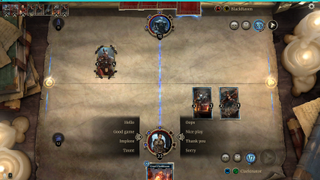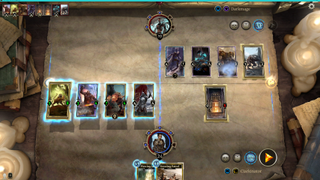
Many digital CCGs have been released in the shadow of Hearthstone’s staggering success, but none have dared take on Blizzard’s money-printing machine headfirst. Instead, games like SolForge, Duelyst, and Hex: Shards of Fate have been content to look for niche success, picking up the leftover audience who are looking for something a bit different. But that’s definitely not the approach The Elder Scrolls: Legends is taking. Having spent some time in the beta, the NDA for which lifted today, I can say for certain that Bethesda is aiming an arrow straight at Blizzard. The question is: will it hit the heart or the knee?
Let’s start with the obvious similarities. Each player begins with a life pool of 30 and a single point of Magicka—Legends' name for Mana. You also get three cards, which you can choose to redraw if you wish. On each subsequent turn, you draw a card and gain one additional Magicka, which you spend to cast spells and play creatures. Kill your opponent's stuff, reduce their life total to zero, and you win. Most of the keywords used to explain effects on the cards have direct equivalents in Hearthstone, so feel instantly familiar. Taunt becomes Guard, Divine Shield becomes Ward, Battlecry becomes Summon, Deathrattle becomes Last Gasp, and Silence becomes, uh, Silence, and so on.

There are some key additions though. Cards with Regenerate on will heal at the start of your turn, whilst those with the Pilfer keyword will trigger an effect whenever they attack. One mechanic not found at present in Hearthstone at all is ‘Breakthrough’, which means excess damage done to a minion will be dealt to the corresponding hero. It’s essentially a riff on ‘Trample’ from Magic: The Gathering, and not the only thing Legends borrows from the venerable paper-based TCG.
There’s going to be greater scope for creative deckbuilding in Legends than in Hearthstone...
Some cards have effects that will only be triggered if the top card of your deck matches their color alignment. As per MTG, Legends uses a color system to give each deck a distinct character. There are five colors/alignments in total, and each deck can only contain cards of one or two colors, plus neutrals. For instance, a purple/Endurance and blue/Intelligence deck will look to grind out the opponent with a mix of big creatures and powerful spells. Whereas an all red/Strength deck will want to go full SMOrc and rush the opponent down.
The color system is certainly intriguing. It means that long term there’s going to be greater scope for creative deckbuilding in Legends than can be found in Hearthstone, which is currently locked to nine heroes based on World of Warcraft classes. This is particularly true because decks in Legends can range between 50 and 70 cards in size, as opposed to being limited to 30.
However, that also makes Legends substantially more intimidating to new players, especially if they’re Skyrim fans who are unfamiliar with CCGs. I also don’t much like the way the color reveal mechanic works. Unlike Hearthstone’s ‘Joust’ system, which operates somewhat similarly, you don’t get to see the top card of your deck. So the effect either triggers or doesn’t, in which case a red X briefly appears on the card. It’s underwhelming.

Why Legends lane system is a game changer
What I do really like about Legends, though, is the lane system. This is by far the most significant feature that separates Bethesda’s game from Blizzard’s. The board (there’s only one available at present) is split vertically down the middle. Whenever you place a new card, you must decide whether to position it in the right or left lane, bearing in mind that cards can only attack creatures in the same lane. (An exception to this occurs with ‘Summon’ effects. When you play a card like Valenwood Huntsman, you may place it in one lane but deal its damage effect in the other.)
The biggest gaming news, reviews and hardware deals
Keep up to date with the most important stories and the best deals, as picked by the PC Gamer team.
This is significant because the lanes can have special effects applied. The right lane will often be a Shadow Lane, meaning that any creature in it can’t be attacked by other creatures that turn. However, they can still be targeted by spells and Summon effects. (I imagine to prevent degenerate strategies from being exploited, along the lines of giving Gadgetzan Auctioneer ‘Stealth’ in Hearthstone.) Anyone with even a vague working knowledge of Hearthstone should be able to grasp immediately what a paradigm shift splitting the board is. It makes creature placement a much more significant consideration.

In Hearthstone, the game is often won by controlling the board and snowballing your opponent to death. But in Legends, you constantly have to consider two board states. It’s often a valid tactic to stall on one side, with beefy Guard minions bogging the opponent down, while keeping your most aggressive creatures attacking face on the other. Equally, on an empty board it’s not always best to place a creature in the Shadow lane, if you think it might need to trade with whatever gets played opposite immediately.
The point is that there’s substantially more scope for strategy, and it feels like that’s a key area Bethesda is trying to excel in. Adding to the depth, you also have Support cards which can be used to trigger a particular effect a limited number of times. For example, the unique sword Goldbrand has three uses, with the damage doubling each time. Another support card is Two-Moons Contemplation, which summons a Priest of the Moon in each lane if your opponent doesn’t attack you that turn, but only happens once. As you’d hope, there are cards that can remove supports, enabling you to tech your deck accordingly.
With over two decades covering videogames, Tim has been there from the beginning. In his case, that meant playing Elite in 'co-op' on a BBC Micro (one player uses the movement keys, the other shoots) until his parents finally caved and bought an Amstrad CPC 6128. These days, when not steering the good ship PC Gamer, Tim spends his time complaining that all Priest mains in Hearthstone are degenerates and raiding in Destiny 2. He's almost certainly doing one of these right now.
Most Popular



